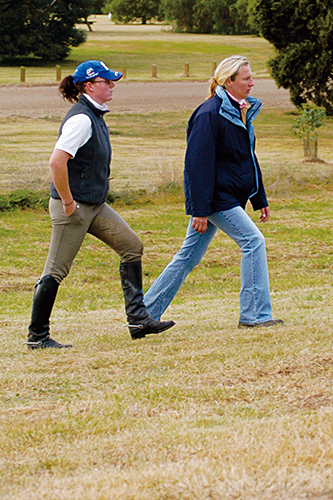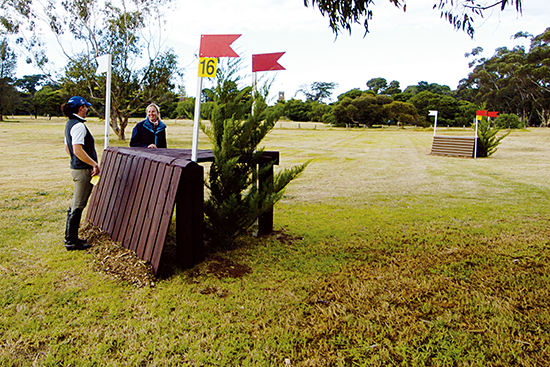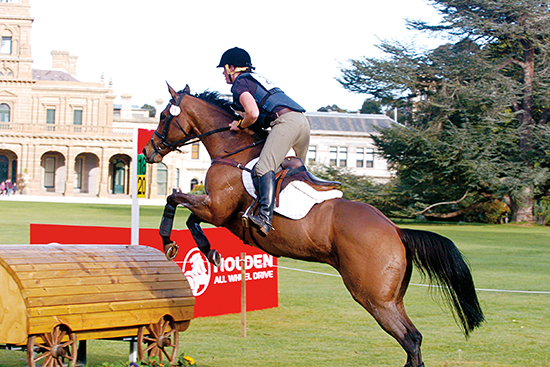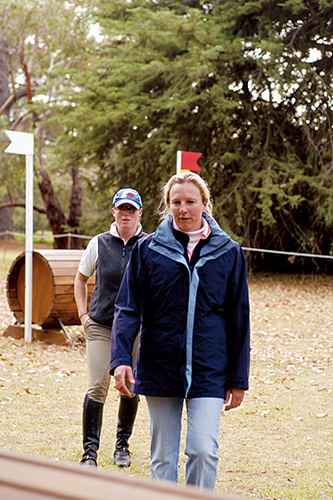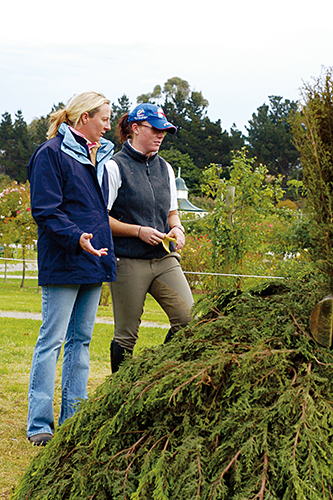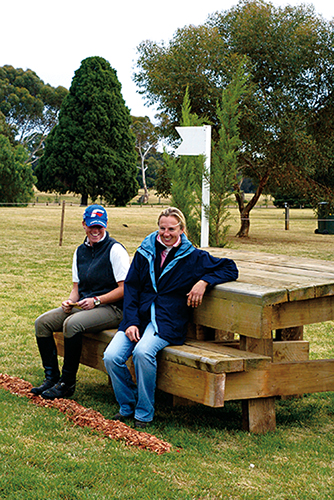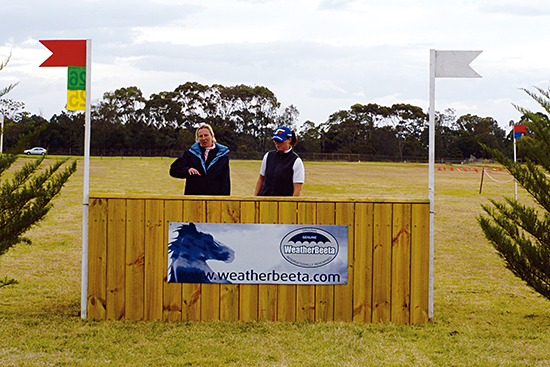Part one:
Part two:
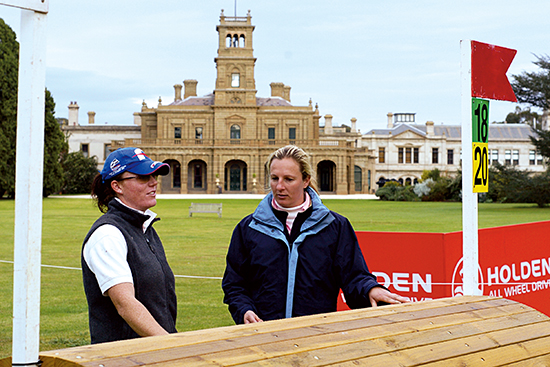 Story by Chris Hector & Photos by Roz Neave
Story by Chris Hector & Photos by Roz Neave
Here we are with 19 year old Tallara Barwick and her coach, Christine Bates, walking the one star course at the Melbourne International Three Day Event. We are half way around the track, with Christine keeping up a running commentary as she explains how her pupil should attack the fences. We have come out of the second water and we are heading for some planks in the Camel Paddock:
Fence 13 – A frame upright palisade
“This is quite a nice turn, keep your canter strong. The fence is vertical enough and to the horse, it is another drop landing. You’ve got a bit of a rise up to it before they see it is not a drop. Keep her head up, you want to set up for this fence, but not over-do it. It is quite straightforward, doesn’t have a drop landing – stay positive coming up to it, because back here, they are going to think it is a drop. Be expecting to feel a ‘oh oh what’s coming’ and be ready to say ‘no it is alright, go’. Fang and the horse will leave a leg. You need to organize. Out of the water, and have a forward nice positive confident jump. It’s a bit of a let up fence.”
And Christine was never going to let Tally forget that the name of the game, was watch your time:
“This area here, the log drop, the water, the turn back, the vertical, that could be a little slow. The moment you jump the vertical, GO – get back to your 520 metres a minute.”
Fence 14 – Big oxer maximum height for One Star
“For this fence you can have a nice good gallop, 20 metres out sit up a little, I want to catch this out of my stride. I don’t want to make it any more complicated than it is. It is a lovely log oxer. So don’t get in her face, just keep travelling around this turn…”
Number 15 – Roll Top
“I would get right on your fence line, and probably now I would be just thinking, hey Cruising, there’s a turn coming up, make sure she is with you, make sure she is listening so you don’t have to make it a big thing, so you can get a nice turn. You can put a bit of an angle on the jump, but don’t take a cheap risk. Don’t be disorganized off your turn and then think, oh hell this is too much angle.
You still give it the respect that it needs because you are jumping it on an angle.”
“Walking from this side, I’d say we’ll go to the right, I might change my mind when I get up next to the fence. You walk the course, seeing how you are going to ride each fence, how you are going to set up each fence, know where your minute markers are – I want you to be able to do your final course walk and it is all automatic – this is what I am aiming at.”
“When you walk the course you always have a picture of how the fence is going to ride, but I always like to have in my mind, well the horse might do this because of the type of fence it is and I am going to be ready for that reaction. I always have plan A, but I always have a plan B in my head.”
“For example she could jump into that water and stall a bit, yet I am not going to lose my position. I want you to think as you walk around, how your position is going to be affected each jump, so by the time you ride cross country it is so in your head, that it happens automatically.”
Fence 16 – Left corner Apex
“It is always good when you have a long gallop to a related fence, to have your marker. Say to yourself – I am going to that tree to set myself up. Here is where I need to be thinking ‘organize’. I would keep galloping to this tree, as I go past the tree I would be thinking, ‘come here, sharpen, there’s my line’ Right I am going to jump straight down there – she has plenty of time to see the line, and you have also given her plenty of time to get a good distance to it.”
“It’s two apexes and so it comes back to the whole technicality side of riding. If you get too in-their-face and backward, you take her eye off it. She’s great with apexes, she is always good with the accuracy fences but it is the same thing – you’ve got to have good distance, good canter, and you must be straight.”
Fence 17 – Left corner Apex
“If you jump the first apex very big and a bit open, this is going to ride a bit short on the five strides, this far round the course they are going to be taking a bigger stride, so be aware of that. Being her size, it is not going to ride short but it is certainly not going to ride long either. It depends how you jump in, how your five is going to come out. You are going to jump this middle to middle. You are not going to put a curve on it. This is not how you should jump this apex correctly, you should be jumping across the middle of the apex, but we are actually jumping quite straight. It is not tall, it is not wide, it is just a matter of holding the line and getting the job done.”
Fence 18 – Log oxer, maximum height
“Land after that oxer, don’t waste time, get motoring again, watch this turn it is really clayey, it’s a fence that is in the trees, it could be a bit darker depending on the weather. Sunday morning on your last course walk, be looking where the shade is, where it is slippery – you need to know that like you know your fences.”
“This is a straight forward oxer but it is going to be a little in the shade, make sure you get her eye on it. Before the turn, and as you are coming through the turn, you will be balanced and able to ride forward to the oxer.”
“When you measure your course, you are not measuring how you would ride it, you are measuring it how the course designer has designed it. Melbourne is renowned for having tight cross country times, so even if when you are measuring you think, this is an impossible line, you’ve got to measure it like that.”
Fence 19 – Ascending oxer, house
“This is a very straight forward fence but in saying that, don’t gallop like a banshee and have a big miss. It is still a fence, you are still not through the finish flags, as far as I am concerned, each fence is given respect until you are through the finish lines. Golden rule, no matter how straightforward it is, give it respect.”
Fence 20 – Roll top wagon
“It’s relatively straight forward, same sort of advice as the last fence. It’s still a fence. Make sure it’s jumped well, but don’t waste unnecessary time over setting up. Organizing through your turn then you should be able to keep travelling to your fence.”
Through the trees to Fence 21a, roll top, and curving line to 21b, another roll top
Suddenly in the beautiful setting of the Mansion formal garden we have what is probably the trickiest fence on the course, a related pair of fences, on a curving line, and under the trees…
“What does the distance walk? I would imagine that we are going to have to be out quite wide. Before we go to where we’ll set up, I want to walk the distances. If it was on the right rein, I’d say you can’t curve it, but being on the left, she does turn well. So we jump it right of centre, it’s very jumpable, if I was on her I would jump it on the two, but I don’t think you have jumped enough of these in training or competition. We are getting to the end of the course, you would be very disappointed if you had a silly 20 here.”
“Here I would rather play safe. You’ve got to get to this fence and give her the feeling that you are landing and going left. If you are too straight and then go to turn, she is sometimes a little slow to react, or she does the opposite and over-reacts. I’d go to the rider’s rep and ask if the tree can be tied up or something to get it out of the way. It probably won’t happen but there is no harm in asking. I’d say they have left the tree like that for a reason.”
“I’d probably want my left shoulder brushing under the tree, you need quite a short, connected canter, a canter where she is thinking what do you want me to do? Where do you want me to go? Be careful with that because she can in that situation get aggressive, I don’t want her landing and grabbing the bit.”
“Try and have her as relaxed and rideable as possible at the first part. If you ride on that line, the three won’t be short. You probably won’t end up putting as much curve on it as I just did walking it. Remember how we jumped through the angles at home – the first time, you really had to ride, whereas the more you did it, it came easier. This should give you the same sort of feeling, that you are going to set it up, and you will probably land, take a stride, and think ‘there it is’, GO.”
“It is imperative that at the first one you get the pace right, and the line right. You’ve had three very simple straight forward fences, now you have a combination, make sure you set her up to read those two logs. The three straight forward fences can put your horse in the mind set, oh we are cruising along, travelling nicely, then all of a sudden – bang – you’ve got quite a technical fence. So don’t get caught out being disorganized.”
Fence 22 – In the Rose Garden, Paradubice, brush with big apron
“By now she may be tired. She shouldn’t be because she has done a lot of miles. Be aware that when they are tired, their reaction time is not as quick as it should be. The horse is probably not as on the job as when you first started. This is another beautifully presented fence, nice brush steeplechase fence but don’t get long and flat to this because they are getting a bit tired. It is more important now to have them a bit organized and hold them together. Don’t get long reins and start losing your position.”
“The Rose Garden is always very slow on your time, you ride as quickly as you can, but I guarantee you’ll come out of the Rose Garden a little down.”
“Watch your turns, especially through gates, keep your outside rein, keep balanced, but stay travelling. Don’t get into the mind-set of ‘I’m down on time’, and start flapping reins and legs, you’ve got to keep them together.”
“They have done a really nice job with the course, it definitely encourages the horse to stay jumping, to stay confident. Certainly there are a few fences that will catch out a green rider or a green horse, but overall for a three day track it is brilliant.”
Fence 23 – Tabletop
“This is a right turn, make sure you don’t let her drift left over it. You want to make sure you jump this and land heading towards the gate. Don’t cut the corner so you are heading to the left when you need to be going to the right. Get the turn and set her up, then you can ride straight and land and go. I think the little slope makes a difference.
Fence 24 – Big log
It is a straight forward log, it is near the end, they are going to be tired, still give it respect, set up for it, don’t just come hooting around the corner and go ‘oh that distance is good enough’ – you’ve got to have good jumps right the way through the course.
Fence 25 – Weatherbeeta ascending oxer
Land, turn, and the same to the last, it is a straight forward fence, but it is not over until you go through those finish flags. Don’t spoil a good round with two shockers because you are going for time, and you end up flat out and not riding professionally at the end of the course.”
At the end of all that, with her two runouts for 20 jumping penalties and her 3.6 time, Tally had slipped down the leaderboard, but she was able to come out the next morning and jump clear with just two time faults to finish her first One Star Three Day Event in 34th place.
Not that Christine was giving her pupil any less of a hard time:
“She actually show jumped clear and the mare jumped well. I think Tally was probably quite disappointed with the way she rode. She got a little backward but that’s a trap of riding indoors for the first time, usually the first thing that happens is that you start to get backwards.”
“She pulled off a clear round, purely because the mare is careful, and Tally did try to resurrect what was going wrong. I was probably tough on her when I said at the finish ‘good thing your horse is careful’. They’ve got to learn that it is tough coming up the grades and there is no point in my being nice to her, she’s here to learn. I think she has probably learned more in the last week than in her whole riding career, about how to ride at a three day and the professionalism and dedication that it takes. It is quite different to a One Day Event, there’s a lot more pressure, and she came here off a win at Coffs Harbour and that put on a bit more pressure, plus the fact she is riding one of my horses and I came to coach her. It’s a big ask for her, but she’s got big shoulders, she always has a smile on her face and that’s what makes her such a great kid to teach.”
And I hope by now you will have some feel not just of Christine Bates and her insight and coaching style, but something of Tally’s good natured determination. She realises that if Christine gives her a blast, it is to teach her something, and that the way to the top is not an easy path.
Still… that’s pretty rough – you jump a clear round showjumping and you still get bawled out?
“She is good, I guess I just got what I deserved, Christine just wants me to ride the best I can, and even though the horse jumped clear, I didn’t ride it as well as I should have. You’ve got to be happy with that I guess – people say, well you left all the rails up and that’s what counts.”
So how do you feel about Melbourne 3DE 2005?
“I wouldn’t say it was the most successful weekend I’ve ever had, but definitely, big learning curve. It’s the first big competition I’ve been to. I finished and I didn’t fall off or do anything too wild, so I’ve got to be happy with that – but better luck next time. The worst thing is the thought of doing it in front of all The Horse Magazine readers!”
I am prepared to bet, that our readers will be seeing more of Tally in the future, because she has what it takes to make the grade, and the help of one of Australia’s smartest trainers. Our thanks to both Christine and Tally for their patience and kindness in letting us intrude on a fairly stressful few days. I hope our readers get as much out of this series of articles as we have all put into making them.
Christine’s Story: the journey to the East
When did you decide to move from Western Australia?
“I had done a couple of trips east – Naracoorte Young Riders when I was fifteen, the Pony Club champs, in ‘93 I went to Gawler and Werribee. At the beginning of 94 I bought Masterprint over for the one star at Lochinvar and decided that this is where I wanted to be, drove the truck home, and a month later packed the truck with all my gear and drove back to Sydney and moved to Prue and Craig Barratt’s.”
“Before I went to Prue and Craig I probably had good jumping basics from Fiona Johns, then later I had a few lessons from David Dobson, always attending showjumping clinics – Chris Chugg, Gavin Chester, Colleen Brook. One thing about Perth, they are always able to get good people over to teach.”
“I had a lot of showjumping experience, but I could not ride dressage to save myself. It was a running joke at Prue and Craig’s, for the first six months I was there I was not allowed to do any rising trot because I was so bad, I could not sit the trot. If it wasn’t for those two, I wouldn’t be able to ride dressage.”
“From that it has grown. Being based at George Sanna’s for seven years, and for the last couple I’ve had Rachael Sanna to ask lots of questions and watch her – and having Roger Fitzhardinge there was always a huge help. More recently there’s been the squad schools at Horsley Park. Much as I would have liked to get back to Prue and Craig more, at least I’ve had a little bit of straight dressage influence. I always felt that was my weakness, dressage, whereas now it is probably one of my strengths.”
“From a coaching point of view I love teaching the dressage especially when it gets to this sort of situation – a week out of Melbourne, and really being able to focus of riding the test. A lot of people won’t teach you that, it is all very well to teach classical riding, and I am sure there are people out there who ride and school their horses better than me, but I’ve learnt to train my horses in a way that I know I can get maximum marks out of them in the test situation. I think that’s probably where a lot of people will let themselves down – actually riding the test.”
Are you a coach or a rider these days?
“I really would like to see myself as a rider, but with the new property move, we really wanted to get this set up and running. Tally really wanted to come and work with us, and a bit of an incentive was that I would give her Devine Story to ride, which has taken away my intermediate ride, and because of the move, I’d given I’m a Skite to Chris Burton to compete, so all of a sudden I didn’t have any horses, but I didn’t really have the time.”
“Since Tally started I’ve been back into it, but I am just a bit horseless at the moment. I don’t see the point in competing in this sport unless you are sitting on something that is really really good, it’s too expensive, it’s too time consuming, I’m looking for horses to go eventing again because as much as I love coaching, I really want to be a rider.”
This article was first published in THM December 2005.
There are more articles with Christine right here:

